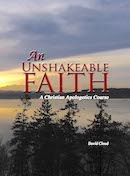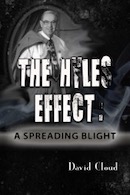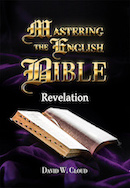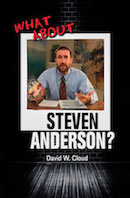866-295-4143, fbns@wayoflife.org
Note from the FBIS editor: A couple of years ago I witnessed the sad breakup of a Christian home, and one of the problems which came out of--and perhaps helped lead to--the breakup was the "inner healing" confusion dealt with in the following article. The wife left a fundamental Baptist church and became involved with charismatics (a Wimber group). After going through inner healing sessions she became convinced that she remembered being sexually abused by her father. Not a hint of such a thing had ever come out before. She called her father and told him she knew dogmatically and without a doubt that he had abused her! What a shocker! How did she know such a thing? Her mind had been occultically manipulated by one of these false teachers. And just as the Bobgan's testify, this wife will not listen to the voice of reason. What wickedness, confusion, and division this inner healing movement is creating. North America, having turned away from the Word of God, is being engulfed with Freudianism and other forms of self-worship. We are thankful for the Bobgans and others who are exposing this wickedness. The Bobgans’ address is Eastgate Publishers, 4137 Primavera Rd., Santa Barbara, CA 93110, http://www.psychoheresy-aware.org/
____________________________________
INNER HEALING: ILLUMINATION OR ILLUSION?
By Martin and Deidre Bobgan
Across America parents are receiving phone calls and correspondence that plunge them into a nightmare of accusations of abuse and incest. These are not parents of young children or teenagers. They are parents of grown children who throughout their lives had had no recollection of being sexually molested by their mother or father. Now, seemingly out of the blue, their bizarre stories are stunning their parents. These adult children, usually daughters, now claim to remember precise details of one of their parents sexually abusing them. Where do they get such ideas? Where do those sordid memories come from? What brings them to the surface? Inner healing and other forms of regressive-type therapy lurk behind this surge of family horror stories.
At first the parents are stunned. They are being accused of sexual exploits that they declare they would never even think of doing. But when they try to talk to their son or daughter, their words fall on deaf ears. They are accused and condemned without a trial--all based upon alleged memories discovered through inner healing. And now they are helpless in their concern over the welfare of their adult child who will have nothing to do with them.
With the media accentuating and exaggerating the numbers of women who have been molested, nearly anyone who cries "incest" is believed beyond a doubt. And why should anyone doubt a grown woman's sudden "recall" of a memory hidden in her unconscious? After all, isn't the memory like a tape recorder or computer that faithfully records and retains every event in some deep unconscious vault of the mind? Aren't there reliable techniques that enable a person to recall past events accurately? Or, are there some problems with those assumptions?
IS THE MIND A COMPUTER?
While many writers of pop psychology continue to equate the human mind with a tape recorder or computer, those are poor and misleading analogies. Dr. John Searle, in his Reith Lecture "Minds, Brains, and Science," explained:
"Because we don't understand the brain very well we're constantly tempted to use the latest technology as a model for trying to understand it.
"In my childhood we were always assured that the brain was a telephone switchboard. ("What else could it be?") And I was amused to see that Sherrington, the great British neuroscientist, thought that the brain worked like a telegraph system. Freud often compared the brain to hydraulic and electromagnetic systems. Leibniz compared it to a mill, and now, obviously, the metaphor is the digital computer. ...
"The computer is probably no better and no worse as a metaphor for the brain than earlier mechanical metaphors. We learn as much about the brain by saying it's a computer as we do by saying it's a telephone switchboard, a telegraph system, a water pump, or a steam engine" (John Searle, "Minds, Brains, and Science," The 1984 Reith Lectures, London: British Broadcasting Corp., 1984, pp. 44,55,56).
What Searle is getting at is the fact that the brain is not a mechanical piece of technology.
Medical doctor-researcher Nancy Andreasen, in her book The Broken Brain, declares that "there is no accurate model or metaphor to describe how [the brain] works." She concludes that "the human brain is probably too complex to lend itself to any single metaphor" (Nancy Andreasen, The Broken Brain, New York: Harper & Row, 1984, p. 90).
Current research demonstrates that computer memory and biological memory are significantly different. In his book Remembering and Forgetting: Inquiries into the Nature of Memory, Edmund Bolles refers to the human brain as "the most complicated structure in the known universe" (Edmund Bolles, Remembering and Forgetting, New York: Walker and Company, 1988, p. 139). He says,
"For several thousand years people have believed that remembering retrieves information stored somewhere in the mind. The metaphors of memory have always been metaphors of storage: We preserve images on wax; we carve them in stone; we write memories as with a pencil on paper; we file memories away; we have photographic memories; we retain facts so firmly they seem held in a steel trap. Each of these images proposes a memory warehouse where the past lies preserved like childhood souvenirs in an attic. This book reports a revolution that has overturned that vision of memory. Remembering is a creative, constructive process. There is no storehouse of information about the past anywhere in our brain" (Ibid., p. xi). [Emphasis added by authors]
After discussing the scientific basis for memory and how the brain functions, he says:
"The biggest loser in this notion of how memory works is the idea that computer memories and human memories have anything in common" (Ibid., p. 165).
He goes on to say, "Human and computer memories are as distinct as life and lightning" (Ibid.).
IS MEMORY RELIABLE?
Unlike a computer, the memory does not store everything that goes into it. First, the mind sifts through the multitude of stimuli that enter it during an actual event. then time, later events, and even later recall color or alter memories. During the creative process of recall, sketchy memories of events may be filled in with imagined details. And, an amazing amount of information is simply forgotten--gone, not just hidden away in some deep cavern of the mind. Memory is neither complete nor fixed. Nor is it accurate. As researcher Carol Tavris so aptly describes it:
"Memory is, in a word, lousy. It is a traitor at worst, a mischief-maker at best. It gives us vivid recollections of events that could never have happened, and it obscures critical details of events that did" (Carol Tavris, "The Freedom to Change," Prime Time, Oct. 1990, p. 28).
Yes, memories can even be created, not from remembering true events, but by implanting imagined events onto the mind. In fact, it is possible for implanted and enhanced memories to seem even more vivid than memories of actual past events.
Under certain conditions a person's mind is open to suggestion in such a way that illusions of memory can be received, believed, and remembered as true memories. Hypnosis, guided imagery, and inner healing are as likely to cause a person to dredge up false information as true accounts of past events. In a state of heightened suggestibility a person's memory can easily be altered and enhanced. This happens under hypnosis, through guided imagery, in age regression therapies (such as primal therapy) and during certain forms of inner healing.
THE POWER OF SUGGESTION
Bernard Diamond, a professor of law and clinical professor of psychiatry, says that hypnotized persons "graft onto their memories fantasies or suggestions deliberately or unwittingly communicated by the hypnotist." Not only may they have new memories, but Diamond declares that "after hypnosis the subject cannot differentiate between a true recollection and a fantasy or a suggested detail." He notes that court witnesses who have been hypnotized "often develop a certitude about their memories that ordinary witnesses seldom exhibit." Diamond declares, "No one, regardless of experience, can verify the accuracy of the hypnotically enhanced memory" (Bernard Diamond, "Inherent Problems in the Use of Pretrial Hypnosis on a Prospective Witness," California Law Review, Mar. 1980, pp. 314,333-337,348).
The certainty of pseudomemories and the uncertainty of real memories render such activities as hypnosis and inner healing questionable at best and dangerous at worst. Because memory is so unreliable, methods of cure that rely on unearthing so-called hidden memories not only open up the possibility of human creativity but also expose the mind to possible demonic suggestion. Even though the hypnotist or inner healer may wish to protect the person from receiving false material, he cannot avoid implanting human suggestion. Nor can he prevent demonic suggestions from entering the vulnerable mind of the person who is in a heightened state of suggestibility.
Even if there are people in the room praying for the person undergoing hypnosis or inner healing, the possibility of lies and fantasies being engrafted into the memory remains. That is because of the involvement in occult activity, which is forbidden in the Bible. Hypnosis and guided imagery are both occult activities, and inner healing may involve hypnotic suggestion, guided imagery, and occult visualization. Hypnotherapist Dr. Joe M. Persinger says that the field of hypnosis "includes meditation, visualization, guided imagery, relaxation, biofeedback, and breathing techniques" (Joe M. Persinger, quoted by Sheri Graves, "Hypnosis: Exploring Deep Levels of the Mind," Santa Barbara News-Press, Sept. 20, 1989, p. D1).
Regarding the relationship between guided imagery and hypnosis, Dr. David Bressler, an authority in the field of hypnosis and imagery says, "I think they're the same thing. It's that simple." He also says, "Imagery is at the heart of all magic" (David Bressler, "The Inner Adviser Technique: The Healer Within," InfoMedix tape, Garden Grove, Calif., 1983).
John Weldon and Zola Levitt say, "We would expect that most if not all of those who are occultly healed are likely to suffer either psychologically or spiritually in some way" (John Weldon and Zola Levitt, Psychic Healing, Chicago: Moody Press, 1982, p. 195).
REALITY OR ILLUSION?
Those who practice inner healing should not be surprised at the possibility of altering or enhancing the memory, because there are times when they purposely attempt to replace bad memories with good memories. They do this through guided imagery and visualization. In fact, one of the seemingly attractive forms of inner healing is to have Jesus enter a painful scene from the past. The inner healer helps the person recreate the memory by having Jesus do or say things that will make the person feel better about the situation. For instance, if a man's dad had neglected him when he was a boy, an inner healer may help that man create a new memory of Jesus having played baseball with him when he was a boy. Through verbal encouragement he would regress him back to his childhood and encourage him to visualize Jesus pitching the ball and praising him for hitting a home run. Some inner healers regress people back to the womb and lead them through rebirthing by guided imagery and imagination. Thus inner healers should recognize the danger of unwittingly enhancing or engrafting memories through words or actions that mean one thing to the inner healer but may communicate something else to the highly vulnerable subject.
It is very likely that people who remember sexual abuse and incest through inner healing are remembering an illusion or distortion of reality, a destructive suggestion accidentally placed there by the inner healer, or created through a combination of stimuli, such as in a nightmare, or worse yet, implanted by demonic influence. Yet they have no doubts about their newly discovered dark memory. In fact, the certainty of the alleged memory has the mark of an hypnotically engrafted memory rather than of a distant reality. And who can or will reveal the truth to them? Probably not their church or other Christians if they have been either supportive or ignorant of inner healing.
THE TRAGIC INFLUENCE OF INNER HEALING
Many Christians have been influenced by such best-selling authors and inner healers as John and Paula Sandford, Rita Bennett, and David Seamonds. Unfortunately those Christians believe such statements as this one from Seamands:
"The realization of grace cannot be maintained in some people without an inner healing of the past. God's care cannot be felt without a deep, inner reprogramming of all the bad conditioning that has been put into them by parents and family and teachers and preachers and the church" (David Seamands, Healing for Damaged Emotions, Wheaton: Victor Books, 1981, p. 85).
Such Christian writers perpetrate false information and encourage erroneous beliefs. In spite of brain research to the contrary, they teach that the mind is like a computer and that there is an unconscious reservoir of hidden, but very powerful memories that highly influence a person's thoughts, attitudes, and actions. And they are convinced that the memories they dredge up are accurate.
This tragic example of people with newly unearthed "memories, caught in a black hole of anger, resentment, unforgiveness, accusations, separation, and confusion, is part of the picture of the damage wrought by those who honestly believe they are helping people. Inner healing practices of regressing into the past, fossicking about in the unconscious for hidden memories, conjuring up images, acting out fantasies and nightmares, and believing lies, resemble the world of the occult, not the work of the Holy Spirit. An imaginary memory created under a highly suggestible, hypnotic-like state will only bring imaginary healing. It may also plunge people into a living nightmare.
We were approached by a woman one day who asked if we knew of a Christian psychiatrist. Months earlier she had enthusiastically exclaimed how she and her daughter had attended an inner healing seminar and had been healed of all kinds of things that they did not even know existed. Now she was desperate. Her daughter was trying to deal with all of the rot that had materialized during inner healing.
The people who are most vulnerable to inner healers are those who are at a low point in their spiritual walk or who are experiencing difficult circumstances. The inner healers entice through all kinds of direct and implied promises for healing damaged emotions, healing roots in the past that prevent personal growth, and enabling a person to have a closer walk with God. They circle about congregations like vultures, waiting for the opportunity to swoop down on those who are near to dropping from spiritual exhaustion. They assure their prospective victims of their sincere desire to help and they communicate a biblical facade by using butchered Bible verses and Christian-sounding conversation.
However, once their talons pierce the person, a penetrating parasitic process begins. And the host/parasite relationship continues as long as the host continues to look to the inner healer to make him emotionally well and spiritually whole.
Instead of being healed, however, there is a very strong possibility that the recipients of inner healing are now living on the basis of a lie from the pit of hell. Inner healing is not based upon truth. It is based upon faulty memory, guided imagery, fantasy, visualization, and hypnotic-like suggestibility. And while the inner healers may conjure up a Jesus and recite Bible verses, such inner healing is not biblical. Jesus said, "If ye continue in my word, then are ye my disciples indeed; and ye shall know the truth, and the truth shall make you free" (John 8:31-32).
We pray that those who have suffered under the abuse of inner healing will be set free through the truth that is in Christ Jesus.
- Receive these reports by email
- www.wayoflife.org
______________________
Sharing Policy: Much of our material is available for free, such as the hundreds of articles at the Way of Life web site. Other items we sell to help fund our expensive literature and foreign church planting ministries. Way of Life's content falls into two categories: sharable and non-sharable. Things that we encourage you to share include the audio sermons, O Timothy magazine, FBIS articles, and the free eVideos and free eBooks. You are welcome to make copies of these at your own expense and share them with friends and family. You may also post parts of reports and/or entire reports to websites, blogs, etc as long as you give proper credit (citation). A link to the original report is very much appreciated as the reports are frequently updated and/or expanded. Things we do not want copied and distributed are "Store" items like the Fundamental Baptist Digital Library, print editions of our books, electronic editions of the books that we sell, the videos that we sell, etc. The items have taken years to produce at enormous expense in time and money, and we use the income from sales to help fund the ministry. We trust that your Christian honesty will preserve the integrity of this policy. "For the scripture saith, Thou shalt not muzzle the ox that treadeth out the corn. And, The labourer is worthy of his reward" (1 Timothy 5:18). Questions? support@wayoflife.org
Goal:Distributed by Way of Life Literature Inc., the Fundamental Baptist Information Service is an e-mail posting for Bible-believing Christians. Established in 1974, Way of Life Literature is a fundamental Baptist preaching and publishing ministry based in Bethel Baptist Church, London, Ontario, of which Wilbert Unger is the founding Pastor. Brother Cloud lives in South Asia where he has been a church planting missionary since 1979. Our primary goal with the FBIS is to provide material to assist preachers in the edification and protection of the churches.
Offering: Offerings are welcome if you care to make one. If you have been helped and/or blessed by our material offerings can be mailed or made online with with Visa, Mastercard, Discover, or Paypal. For information see: www.wayoflife.org/about/makeanoffering.html.





